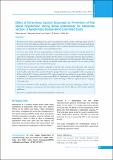Please use this identifier to cite or link to this item:
https://hdl.handle.net/20.500.14356/1014| Title: | Effect of Intravenous Calcium Gluconate on Prevention of Post Spinal Hypotension during Spinal Anaesthesia for Caesarean Section: A Randomized Double-Blind Controlled Study |
| Authors: | Agarwal, Shilpa Kumar, Mahender Rautela, RS Jain, Nidhi |
| Citation: | AgarwalS., KumarM., GuptaA., RautelaR., & JainN. (2022). Effect of Intravenous Calcium Gluconate on Prevention of Post Spinal Hypotension during Spinal Anaesthesia for Caesarean Section: A Randomized Double-Blind Controlled Study . Journal of Nepal Health Research Council, 20(01), 89-95. https://doi.org/10.33314/jnhrc.v20i01.3882 |
| Issue Date: | 2022 |
| Publisher: | Nepal Health Research Council |
| Article Type: | Original Article |
| Keywords: | Cesarean section fetal acidosis hypotension vasopressors |
| Series/Report no.: | Jan-March, 2022;3882 |
| Abstract: | Abstract Background: Calcium, a physiological ion, causes vasoconstriction and has a positive ionotropic action on heart. Its use to prevent post-spinal hypotension has been suggested but never formally evaluated for patients undergoing caesarean section. This study investigated the hemodynamic effects of calcium administration in parturients with the primary aim of comparing the incidence of post-spinal hypotension. Methods: Sixty healthy full-term pregnant patients scheduled for caesarean section were randomly allocated to two equal groups to receive either calcium gluconate or normal Saline bolus over 20min by syringe infusion pump under electrocardiography monitoring immediately after the patient was turned supine following spinal anaesthesia. Blood pressure and heart rate were recorded at baseline, and at regular intervals following spinal. Maternal calcium levels were estimated before and after infusion. Neonatal blood gas analysis and calcium level were analyzed. Total mephentermine requirement was recorded in both groups. Results: The heart rate values remained comparable to baseline value in group calcium gluconate while in group normal Saline, it decreased significantly at 8,12 and 16min. Blood pressure decreased significantly as compared to the baseline value from 4min onwards in both the groups. However, it was comparable in the two groups at all time points(0.622). Nineteen patients(63.33%) required mephentermine infusion in group calcium gluconate as compared to 23 patients(76.6%) in group normal Saline for maintenance of systolic blood pressure.(p=0.791) Umbilical venous pH (p=0.038) and partial pressure of carbon dioxide(p=0.038) were significantly better in group calcium gluconate. Conclusions: Calcium used for prophylaxis of hypotension in healthy parturients undergoing caesarean section reduced the vasopressor requirements and total mephenteramine dose, but the difference did not attain statistical significance. Keywords: Cesarean section, fetal acidosis, hypotension, vasopressors. |
| Description: | Original Article |
| URI: | http://103.69.126.140:8080/handle/20.500.14356/1014 |
| ISSN: | Print ISSN: 1727-5482; Online ISSN: 1999-6217 |
| Appears in Collections: | Vol. 20 No. 01 (2022): Issue 54 Jan-March, 2022 |
Files in This Item:
| File | Description | Size | Format | |
|---|---|---|---|---|
| 3882-Manuscript-28637-1-10-20220719.pdf | Fulltext Download | 398.38 kB | Adobe PDF |  View/Open |
Items in DSpace are protected by copyright, with all rights reserved, unless otherwise indicated.
